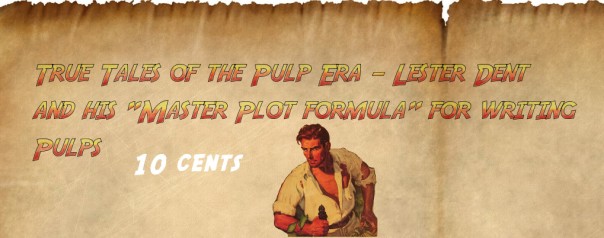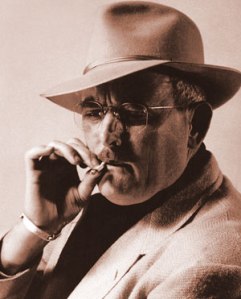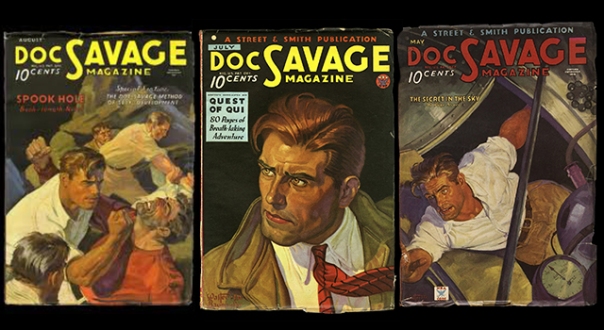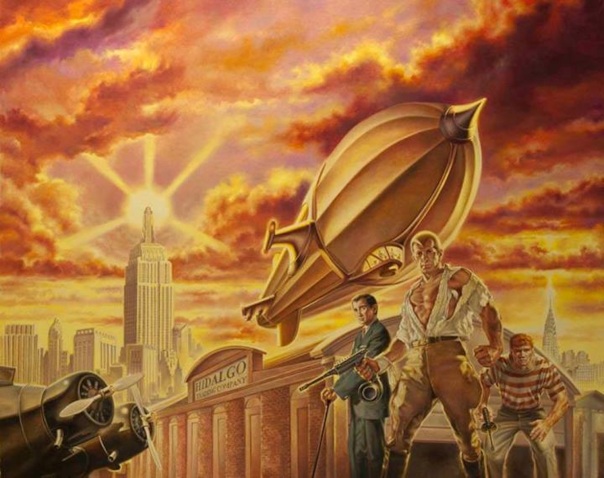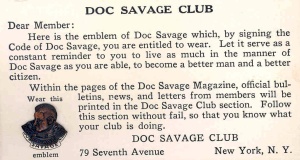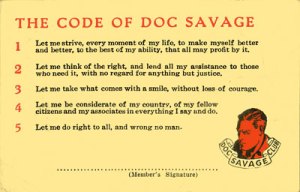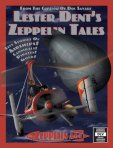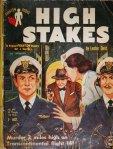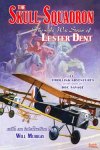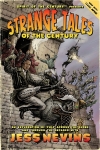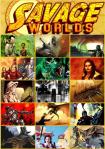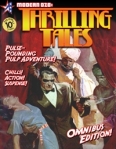Category Archives: Author Profiles
True Tales of The Pulp Era – The story of Lester Dent and his “Master Plot Formula” for writing Pulp stories.
Posted by thestrangersbookshelf
The pulps what a fascinating time in literature it was. From the 1920’s to the 1950’s when TV’s and paperback novels took over, serialized and short fiction were the main forms of inexpensive entertainment. For only a dime you could have been whisked away to far distant lands and planets. Ride along with a hero that uses his wits and two fists to get him out of trouble and win the girl of his dreams.
Many of America’s top writers got their start in the pulp industry. Authors like Robert E Howard (the godfather and creator of the sword and sorcery genre), Dashiell Hammett (The purveyor of the hardboiled noir),H.P. Lovecraft (The creator of weird and modern horror) and Ray Bradbury (One of the greatest science-fiction and fantasy writers of all time) just to name a few. These authors and hundreds of others churned out thousands upon thousands of words a day for no more than one cent a word, A grueling existence if any. It was tough times back then, the United States was between wars, and the stock market crashed throwing the country into the great depression which resulted in mass unemployment. Moral was down and over three quarters of the population were homeless and starving. Many turned to the pulps as a form of escape from the mundane world.
For these writers it was like crafting a Japanese sword before the Meiji Restoration The more work they could get, the more they wrote all contributed to strengthening their craft. It was similar to the forging and metallurgy techniques that were learnt to craft some of the most powerful swords in the world. Many writers fell by the wayside, penniless along the way, like the sword crafters whose steel wasn’t sufficient to hold a sharp edge or withstand the oncoming blow of an attacker. Those who did push the boundaries with their craft, having superhuman word counts went on to be legends like Masamune and Muramasa the most revered swordsmen in Japan.
One of the most prolific writer of that time period was Lester Dent the creator of Doc Savage, who in a lot of ways was the very first superhero and the precursor to the modern action hero.
Lester Dent was an amazing individual; he was six foot three inches and a solid 200 pounds of muscle. A flamboyant dresser who cultivated a narrow mustache or a full beard depending on the mood he was in could almost pass for one of his famous heroes that he wrote about. And just like the protagonist of his stories Doc Savage, Lester Dent possessed vast and arcane knowledge in several fields of expertise and was a master of assorted technical skills. He was a pilot, electrician, radio operator, plumber and architect. Lester taught himself architecture and draftsmanship to the point where he designed and built his own house from scratch. He was also an avid explorer and treasure hunter just like Doc Savage. Lester would explore vast deserts looking for lost cities and sailing the tropic waters around the world in search of treasure. It is well documented that for three years he sailed the Caribbean on his yacht the Albatross. Diving for treasure during the day as his wife would recall, and sitting on the deck writing Doc Savage stories all night. Lester traveled around the world so much and left his mark in several places that it earned him a membership in the famed New York explorers club.
When Lester dent got his start in writing he originally was a learned telegraph man who went to work for $45 a month and would study law on his nights off. While working a night shift at the telegraph office, Lester Dent decided to turn his hand to writing adventure stories. It was hard going at first, like most authors he learned rejection of his work from early on. His first thirteen stories nobody would even look at, but his fourteenth story sold for $250.00 setting him on the path to stardom. A few months later a large New York Publisher sent Dent a telegraph saying “if you make less than $100.00 a week at your present job, we advise you to quit; come to New York and be taken under our wing with a $500.00 a month drawing account.” This was in 1931. Two years later in 1933 he took on the job of writing Doc Savage for the publisher Street and Smith under the house name Kenneth Robeson as a freelance writer. He retired seventeen years later and produced over one hundred and eighty one stories, some which were novel length in size. Because of his great storytelling and high work output Lester Dent has come to be regarded as one of the supreme highlights of the pulp era and arguably one of the greatest achievements in American popular fiction.
A lot of what constitutes today as superhero and adventure fiction can be attributed to Dent’s work on penning Doc Savage. “The Man Of Bronze” was created by Henry W Ralston editorial executive at Street and Smith publishing and Shadow editor John Nanovic during a series of editorial sessions which produced a thirty page outline of the character and concepts which they gave to Dent to use to pen their creation. Doc Savage: the man of bronze combined the clue following ability of Sherlock Holmes and the tree swinging ability of Tarzan. He owned a penthouse on the eighty six floor of the Empire State building (something a young Stan Lee would use in 1960 when he created the Fantastic Four and their headquarters in the Baxter building). Doc also had a Fortress of Solitude in the artic long before Jerry Siegel and Joe Shuster even dreamed up their own Superman. Heck even the Man of Steel and the name Clark Kent was very close to plagiarization as Doc Savage: the man of bronze real name was Clark Savage Jr. The Man of Bronze moniker comes from the hue of Doc Savage’s skin and hair which is bronze in color. Doc Savage had more gadgets than both James Bond and Batman could shake a stick at. Doc was the ultimate Übermensch , he was a trained surgeon, chemist, physicist, gadgeteer and adventurer. He could speak almost any language and was of the physique that only athletes could only dream about. If that wasn’t enough Doc was aided by his posse of five experts who were all the top on their field of studies as well as endless supply of income at his disposal due to owning a rare Mayan gold mine that is reputed to be Eldorado.
Boys and men of all ages loved spending their hard earned dime on the tale of Doc Savage during the 1930’s and 1940’s. Interestingly enough when paperbacks started taking over in the 1960’s and publishing houses started reprinting the old Doc Savage stories in this format, there was a resurgence of interest which involved a newer younger audience, a lot who were the children and grandchildren of those previous readers.
Lester Dent was so prolific with writing pulp style tales that he actually came up with an amazing system for writing called “the master fiction plot” often referred to as the Lester Dent formula for writing pulp fiction. Dent’s own personal recipe for plotting high-powered adventure fiction appeared under his by-line in a 1939 issue of writer’s digest. The article was unpretentious as Dent was himself. Suspense he opined , is the sugar that draws the flies. Among other things he admonished the would-be writer to introduce the hero as quickly as possible and immediately swat him with a fist full of troubles; introduce a menace strong enough to hang like a cloud over the hero; have at least one minor surprise per printed page; keep shovelling grief onto the hero. “The idea” Dent wrote, “is to avoid monotony”.
His formula worked and if you look at several writers in that era you will see his formula in use. Robert E Howard’s Conan is a perfect example of the Lester Dent Formula. If you get a chance pull up a chair and read one of the short Conan stories that Howard wrote in the 1930’s and compare it to the Lester Dent formula that I added at the end of this article. See the similarities of the plot outline. You can also do that with any other writer of that era (like the ones I mentioned above) Lester Dent’s Master Plot Formula is still used extensively today. Aside from being an excellent tool as exercises for writing groups, you can also see it in use for Role Playing Game design, and we are not just talking about pulp styled games here. Savage Worlds Plot Point design for creating scenarios for game masters reads very similar to the Lester Dent’s formula, FATEcore 3e same thing, which is really interesting because I know of a lot of schools that use FATEcore in their curriculum to teach storytelling in English class. A lot of authors also use FATEcore as an inspiration to create their world-building and plot ideas.
It is a shame that the days of the pulps are gone and the world of fictional literature is changing as we speak. Paper is going by the wayside in favor of E-Books and electronic readers. People are now turned onto a more interactive entertainment like video games and Facebook. The plus side to this is that now it is a lot easier to get published and sell your stories through Amazon at the fraction of what a book costs, and as our economy is starting to look like tough times again, the days of pulp fiction might return to its former glory. Yes, it might be in a different format but there is going to be the need for inexpensive entertainment in the near future and who knows maybe you might be the next Lester Dent.
Here is the Lester Dent formula outlined in all its glory as it was published in 1939 in Writer’s Digest. It is an excellent technique for strengthen your writing craft. If you have the time, try writing a short story or a role-playing game scenario using the Lester Dent formula and let me know if it works for you.
This is a formula, a master plot, for any 6000 word pulp story. It has worked on adventure, detective, western and war-air. It tells exactly where to put everything. It shows definitely just what must happen in each successive thousand words.
No yarn of mine written to the formula has yet failed to sell.
The business of building stories seems not much different from the business of building anything else.
Here’s how it starts:
1. A DIFFERENT MURDER METHOD FOR VILLAIN TO USE
2. A DIFFERENT THING FOR VILLAIN TO BE SEEKING
3. A DIFFERENT LOCALE
4. A MENACE WHICH IS TO HANG LIKE A CLOUD OVER HERO
One of these DIFFERENT things would be nice, two better, three swell. It may help if they are fully in mind before tackling the rest.
A different murder method could be–different. Thinking of shooting, knifing, hydrocyanic, garroting, poison needles, scorpions, a few others, and writing them on paper gets them where they may suggest something. Scorpions and their poison bite? Maybe mosquitos or flies treated with deadly germs?
If the victims are killed by ordinary methods, but found under strange and identical circumstances each time, it might serve, the reader of course not knowing until the end, that the method of murder is ordinary.
Scribes who have their villain’s victims found with butterflies, spiders or bats stamped on them could conceivably be flirting with this gag.
Probably it won’t do a lot of good to be too odd, fanciful or grotesque with murder methods.
The different thing for the villain to be after might be something other than jewels, the stolen bank loot, the pearls, or some other old ones.
Here, again one might get too bizarre.
Unique locale? Easy. Selecting one that fits in with the murder method and the treasure–thing that villain wants–makes it simpler, and it’s
also nice to use a familiar one, a place where you’ve lived or worked. So many pulpateers don’t. It sometimes saves embarrassment to know nearly as much about the locale as the editor, or enough to fool him.
Here’s a nifty much used in faking local color. For a story laid in Egypt, say, author finds a book titled “Conversational Egyptian Easily Learned,” or something like that. He wants a character to ask in Egyptian, “What’s the matter?” He looks in the book and finds, “El khabar, eyh?” To keep the reader from getting dizzy, it’s perhaps wise to make it clear in some fashion, just what that means. Occasionally the text will tell this, or someone can repeat it in English. But it’s a doubtful move to stop and tell the reader in so many words the English translation.
The writer learns they have palm trees in Egypt. He looks in the book, finds the Egyptian for palm trees, and uses that. This kids editors and readers into thinking he knows something about Egypt.
Divide the 6000 word yarn into four 1500 word parts. In each 1500 word part, put the following:
FIRST 1500 WORDS
1–First line, or as near thereto as possible, introduce the hero and swat him with a fistful of trouble. Hint at a mystery, a menace or a problem to be solved–something the hero has to cope with.
2–The hero pitches in to cope with his fistful of trouble. (He tries to fathom the mystery, defeat the menace, or solve the problem.)
3–Introduce ALL the other characters as soon as possible. Bring them on in action.
4–Hero’s endevours land him in an actual physical conflict near the end of the first 1500 words.
5–Near the end of first 1500 words, there is a complete surprise twist in the plot development.
SO FAR: Does it have SUSPENSE?
Is there a MENACE to the hero?
Does everything happen logically?
At this point, it might help to recall that action should do something besides advance the hero over the scenery. Suppose the hero has learned the dastards of villains have seized somebody named Eloise, who can explain the secret of what is behind all these sinister events. The hero corners villains, they fight, and villains get away. Not so hot.
Hero should accomplish something with his tearing around, if only to rescue Eloise, and surprise! Eloise is a ring-tailed monkey. The hero counts the rings on Eloise’s tail, if nothing better comes to mind.
They’re not real. The rings are painted there. Why?
SECOND 1500 WORDS
1–Shovel more grief onto the hero.
2–Hero, being heroic, struggles, and his struggles lead up to:
3–Another physical conflict.
4–A surprising plot twist to end the 1500 words.
NOW: Does second part have SUSPENSE?
Does the MENACE grow like a black cloud?
Is the hero getting it in the neck?
Is the second part logical?
DON’T TELL ABOUT IT***Show how the thing looked. This is one of the secrets of writing; never tell the reader–show him. (He trembles, roving eyes, slackened jaw, and such.) MAKE THE READER SEE HIM.
When writing, it helps to get at least one minor surprise to the printed page. It is reasonable to to expect these minor surprises to sort of inveigle the reader into keeping on. They need not be such profound efforts. One method of accomplishing one now and then is to be gently misleading. Hero is examining the murder room. The door behind him begins slowly to open. He does not see it. He conducts his examination blissfully. Door eases open, wider and wider, until–surprise! The glass pane falls out of the big window across the room. It must have fallen slowly, and air blowing into the room caused the door to open. Then what the heck made the pane fall so slowly? More mystery.
Characterizing a story actor consists of giving him some things which make him stick in the reader’s mind. TAG HIM.
BUILD YOUR PLOTS SO THAT ACTION CAN BE CONTINUOUS.
THIRD 1500 WORDS
1–Shovel the grief onto the hero.
2–Hero makes some headway, and corners the villain or somebody in:
3–A physical conflict.
4–A surprising plot twist, in which the hero preferably gets it in the neck bad, to end the 1500 words.
DOES: It still have SUSPENSE?
The MENACE getting blacker?
The hero finds himself in a hell of a fix?
It all happens logically?
These outlines or master formulas are only something to make you certain of inserting some physical conflict, and some genuine plot twists, with a little suspense and menace thrown in. Without them, there is no pulp story.
These physical conflicts in each part might be DIFFERENT, too. If one fight is with fists, that can take care of the pugilism until next the next yarn. Same for poison gas and swords.There may, naturally, be exceptions. A hero with a peculiar punch, or a quick draw, might use it more than once.
The idea is to avoid monotony.
ACTION:
Vivid, swift, no words wasted. Create suspense, make the reader see and feel the action.
ATMOSPHERE:
Hear, smell, see, feel and taste.
DESCRIPTION:
Trees, wind, scenery and water.
THE SECRET OF ALL WRITING IS TO MAKE EVERY WORD COUNT.
FOURTH 1500 WORDS
1–Shovel the difficulties more thickly upon the hero.
2–Get the hero almost buried in his troubles. (Figuratively, the villain has him prisoner and has him framed for a murder rap; the girl is presumably dead, everything is lost, and the DIFFERENT murder method is about to dispose of the suffering protagonist.)
3–The hero extricates himself using HIS OWN SKILL, training or brawn.
4–The mysteries remaining–one big one held over to this point will help grip interest–are cleared up in course of final conflict as hero takes
the situation in hand.
5–Final twist, a big surprise, (This can be the villain turning out to be the unexpected person, having the “Treasure” be a dud, etc.)
6–The snapper, the punch line to end it.
HAS: The SUSPENSE held out to the last line?
The MENACE held out to the last?
Everything been explained?
It all happen logically?
Is the Punch Line enough to leave the reader with that WARM FEELING?
Did God kill the villain? Or the hero?
I am Eric from The Strangers Bookshelf and Happy Writing.
